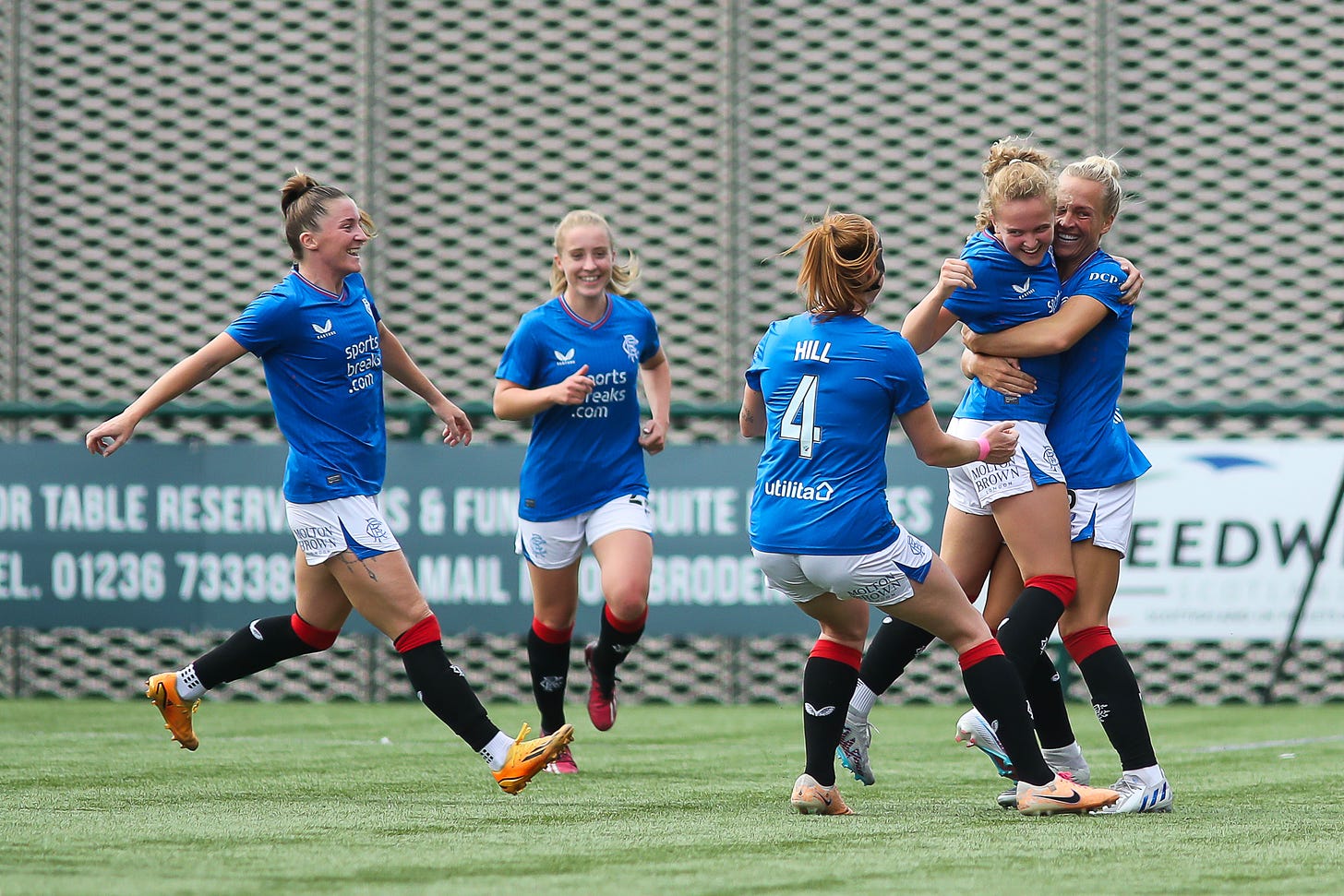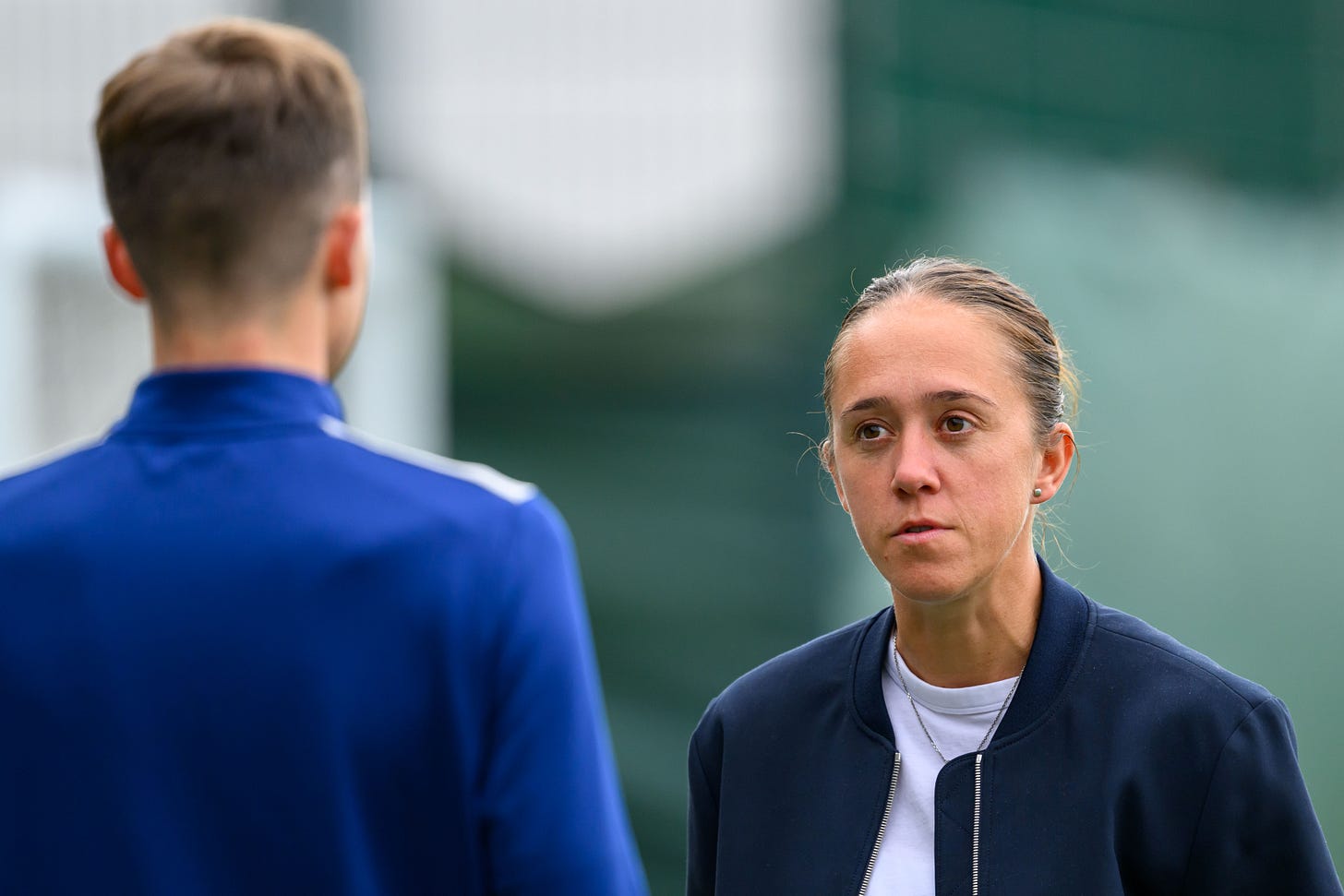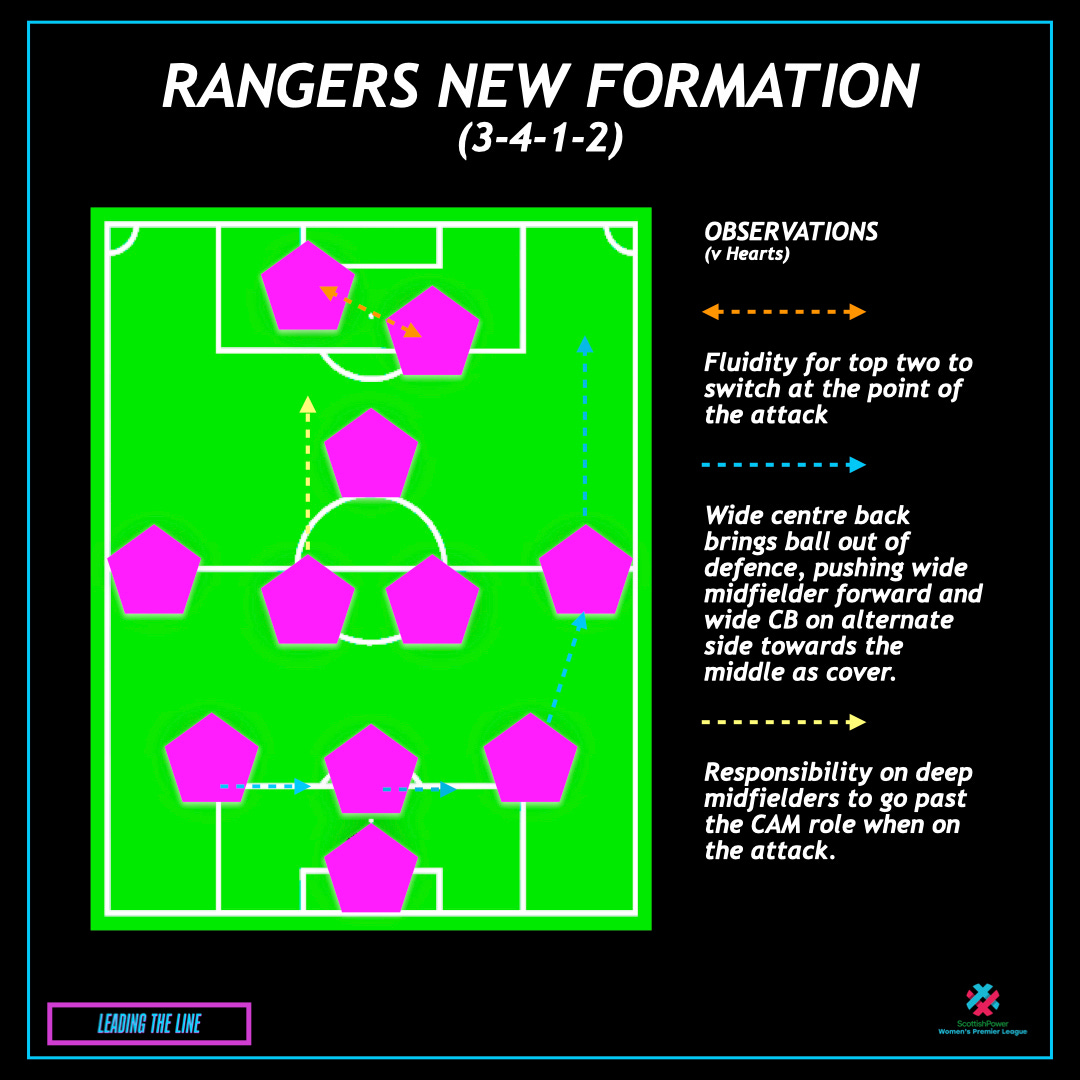The Breakdown: Rangers A New Formation
With three SWPL wins from three how can we assess Rangers' tactical evolution under new boss, and former Lioness Jo Potter.
Rangers made it three wins from three on Wednesday night despite a late surge from a Hearts side who will be looking to pick up a victory and close the gap on last season’s top three.
Goals from Chelsea Cornet and Rio Hardy were enough to secure victory for Jo Potter’s side, in a game where the growing pains of a new formation flashed their teeth in the early stages before showing its potential benefits as the season continues with one eye cast towards the visit of champions Glasgow City to Broadwood this Sunday.
So what has the former England international and Birmingham City Assistant Head Coach changed and how has that change worked in the opening weeks of the season? On The Breakdown, we will try to shed some light on Rangers new formation, and how the players at Potter’s disposal may complete the puzzle as the season progresses.
The End of the Malky Thomson Era
Before looking forward it is important to look back and despite a first Sky Sports Cup victory last season was one tinged with disappointment for the 2021/22 SWPL Champions, a final day loss at Ibrox to Glasgow City saw them miss out on both retaining their title and a spot in the Champions League play-off rounds.
A week later in the Scottish Cup Final against Celtic Malky Thomson, who in the week of the final announced he would be moving on following a three and half year stint in charge, ended his tenure with a 2-0 defeat in a game that the opposition would dominate at Hampden.

Under Thomson, Rangers would usually approach games lined up in a 4-2-3-1 with occasional tweaks made over the course of the season. The system’s strength would lie in its utilisation of space on the flanks with wide forwards (such as Brogan Hay, Lizzie Arnot and Emma Watson) paired with overlapping full-backs (Rachel McLauchlan, Maddie Nolf and Nicola Docherty) providing attacking support to a single focal point at the head of the attack. It was an ethos that the 55-year-old would rarely stray from and there was a frustration from Rangers fans that changes relating to both personnel and formation may have been too slow to come, particularly in crunch moments against title rivals Celtic and Glasgow City.
While the end of Thomson’s time in charge ended in defeat his time in charge should be reflected on fondly by Rangers supporters as the sands of time move erode recent disappointments. A personable coach who was popular with anybody he spoke to, he embraced women’s football providing Rangers a first ever SWPL title as well as giving opportunity to a talented crop of youngsters. However, as the Glasgow side look to move their programme on to the next level the timing felt right for Thomson to step aside this summer.
So who is Jo Potter?
Even though there appeared to be no standout candidates the appointment of Jo Potter as Rangers Head Coach in June was one that caught many, including this guy, by surprise as, for the first time in her career, the 38-year-old is the boss. A former England International she was part of the side that claimed a bronze medal at the 2015 World Cup in Canada. She followed a four year spell coaching at English Championship side Coventry United with a year long stint as Assistant Head Coach at league rivals side Birmingham City. Social media is by no means a scientific metric for future success but the noise from those that regularly follow the Blues indicate that Potter left with high expectiations and her wealth of experience in the women’s game both on the field and off it adds a new dimension to a Rangers dugout lacking that insight last season following the departure of Kevin Murphy to Arsenal.
The 35-times capped international, who, over a 21 year playing career, also competed at the highest level in the English club game established herself in midfield but would also feature in both defence and on the left flank.
During her first interview with Rangers TV, Potter would speak of her desire to maintain a player’s perspective on her approach whilst also hinting at the type of game she would look for her new side to play, “I like my teams to be aggressive in possession and out of possession. I like a possession based game. I like to win. I like to be adaptable…playing a certain way that feels good to play.” She would also acknowledge the demands that will come with her new role where investment expects success and how she goes about achieving that will no doubt garner interest from both sides of the border.

Rangers fans get familiar with a 3-4-1-2
So how has Potter set about making her mark?
With still a week remaining of the transfer window it remains to be seen if more new faces will arrive but acquisitions including that of Welsh international Rachel Rowe (from Reading) along with the prolific duo of Rio Hardy (from Durham) and Sarah Ewens (from London City Lionesses) has shown a willingness to shop in familiar markets down south while the arrival of Belgian international Michelle Colson show that scouting eyes are still being cast further afield.
There has also been the continuation of the “if you’re good enough, you’re old enough” policy that Thomson oversaw during his tenure with Mia McAulay and Laura Berry the latest two prospects to be signed on professional terms. Both scored their first competitive senior goals in the opening weeks of the season while Jenna Ferguson (on loan to Partick Thistle) and Kayla Jardine (expected to return on loan to Motherwell this term) are just two of the latest additions to the Light Blues’ talent factory.
How the squad will take it’s final form is yet to be seen but what has been clear is that Potter is keen to shift Rangers on-field structures, moving away from the 4-2-3-1; rearranging those numbers into a new 3-4-1-2 configuration.
Balance key to a progressive back three
During the opening stages of Wednesday night’s contest at Oriam the shouts of “shape” were clear to be heard from the Rangers dugout and as the game continued it would become clear that it is an evolution still in progress. In conversation after her side’s 2-1 victory in Edinburgh Potter had the following to say about how the squad was adjusting to the new style of play, “We're ahead of where I thought where we would be, if we'd taken a couple of the one-on-one opportunities and if we were a bit more ruthless in front of goal it would have been less nervy.”
This new style starts in defence and in Rangers opening two SWPL fixtures Kathryn Hill had been flanked by natural full backs Nicola Docherty (to the left) and Rachel McLauchlan (to the right) as part of a defensive three. Against Hearts though Michelle Colson was drafted in with Docherty stepping up to fill one of the two vacant defensive midfield roles, a move Potter confirmed was out of necessity more than by design.
At its best the system sees one of the wide centre backs bring the ball out of defence to start an attack, pushing the midfielder on the same side further up the pitch in the process; the remaining defenders shuffling in behind to make a central two.
In the first half at Oriam Hill was asked to step into Docherty’s role on the right hand side with Michelle Colson stepping into the centre. It was a move that altered the balance of the backline and despite conceding in the closing stages it became apparent that when Docherty stepped back into the three (Colson was replaced by returning defensive midfielder Teasel Middag in the 63rd minute) the motions both defensively and in attack felt much more fluid with Hill anchoring in the central role, allowing for Docherty and McLauchlan to carry the responsibility of bringing the ball forward.
With French centre back Lisa Martinez still on the road to recovery following an ACL injury picked up during a 1-1 draw with Celtic last season it remains to be seen if McLauchlan and Docherty’s move to a three will become permanent or if reinforcements will arrive. What will be key is the speed in which that back three can progress the ball, particularly in those games where they will have to battle to break down their opposition.
How the system utilises width
Any potential transfer activity becomes even more intriguing when assessing what role the wide midfielders play in Potter’s system. On paper it is a position that both Docherty and McLauchlan would seem perfectly suited to thrive in. McLauchlan in particular has become well known for her marauding runs down Rangers right hand side while Docherty has established herself as Scotland’s first choice left back, both would be comfortable playing, what in essence, becomes an advanced wing-back role but they are not the only options.
In the stands as the sun began to set on Wednesday evening was PFA Scotland Player of the Year nominee Brogan Hay, Northern Ireland International Megan Bell and the two-footed Lizzie Arnot. Hay and Arnot in particular have played significant roles in Rangers recent successes and, along with Bell, would provide a far more attack focused outlet, especially against those sides where Rangers will be expected to claim victory, especially in a title race where goal difference really could matter once the season reaches it’s business end.
Of course to reference those watching on overlooks those who have been playing the roles in the opening weeks of the campaign. Having seen both Emma Watson and Kirsty MacLean make their way into the SWNT set up both Jodi McLeary and now Mia McAulay will be aware of the opportunity that they have been presented. McLeary’s relentless energy is already well established at SWPL level while McAulay signalled her blossoming potential with two goals at home to Aberdeen last weekend, her first in particular a howitzer of the highest order.
It is not just in attack that these positions play a significant role in Potter’s system though as with one less body to occupy opposing threats on there is a huge physical effort required to cover the length of the pitch in situations where a Rangers wide midfielder may find themselves outnumbered, although support should come from wide centre backs on either side.
Establishing a base and how to create chances
While the establishing of a solid base will be key to Rangers success in the months to come it is the one in the 3-4-1-2 that should have fans particularly excited, especially when that one is occupied by the twinkling feet of Scotland’s newest full international Kirsty Maclean. With Emma Watson’s departure Maclean is viewed by most as the next Scottish midfield megastar in waiting. Her ability to float between defensive lines, thread passes and to nimbly navigate her way out of the tightest of spaces continues to see “Ini” light up the league. This season she will also be able to alternate with and learn from the vastly experienced Rachel Rowe, the Welsh midfielder having just completed an eight year sting with Reading in the WSL, providing variety in an area of the pitch where Rangers struggled to find the alchemy for last term.
That floating attacking role also provides a conundrum for the opposition as to whether to stick or twist in leaving Rangers attacking fulcrum unattended. For Hearts Republic of Ireland international Ciara Grant operated in the vicinity of the teenager for the majority of the game, in what was an intriguing battle all of its own. If the opposition do become pre-occupied then runs from deep can penetrate, as evidenced by the move that led to Rangers opener. One started by McLauchlan stepping forward, the ball transitioning through Rio Hardy to release Chelsea Cornet who had run from deep to finish smartly.
Rangers’s counter-attacking second was an example of the fluidity expected of the front two in this new system. On Wednesday it was Hardy supporting last season’s top goalscorer Kirsty Howat, but for the goal it would be Howat the provider. Her pressure on Esther Morgan seeing the striker break free before squaring the ball for Hardy to finish.
At times, Howat would be an isolated figure, and so the addition of a second striker, along a more defined role for a creative number ten could help to bridge that attacking gap.
Watch Highlights of Rangers v Hearts here
So can opposition get at it
It wasn’t plain sailing against the side that finished fourth last term and Hearts can take…well, heart, from a game where it didn’t ever feel like they were truly out of it, even at 2-0 down. One of the more interesting statistics to come out of Wednesday night’s contest was that it was the home side that would generate the most expected goal chances (Hearts 2.11xG outperforming Rangers 1.05xG).
Those statistics are in part boosted by a late onslaught in which Eva Olid must have felt that her side were set to get the equaliser she felt the performance deserved, with both with Danni Findlay and Kathleen McGovern going close but that grandstand finish was only possible due to the groundwork that saw Hearts remain competitive in a game where they also got the better of their visitors in contested duels, winning 57% compared to Rangers 40%.
Lining up with a tweaked 4-5-1 at the National Performance Centre Hearts would strive to match up to Rangers defensive trio, something that future opposition may look to do. Turning each contest into a head-to-head battle. Kathleen McGovern, who would score Hearts goal, operated at the point supported by the width of Georgia Timms, Addie Handley and later new signing Sade Adamolekun. The addition of the industrious former Hibernian forward Katie Lockwood meant that on occasion Rangers would face an attacking overload in transition.
So can it work going forward
Three wins from three, plus a pair of victories in the Glasgow Cup suggest that yes it can but like all formations, especially those that are new, it will come with its own unique set of challenges.
Establishing the outlets both from the back and on the flanks will be crucial for a side that will spend the majority of the season on the front foot. The good news for Potter, if you want to frame it that way, is she will get the opportunity to put her philosophy to the test once again this Sunday against defending champions Glasgow City in what should be a step up from the stern test Hearts offered on Wednesday.
As Rangers new Head Coach admits, it is yet to be the finished article with cards still to be added to the deck, but in a title race where results in head-to-head contests will be crucial, progression on Sunday could become an important indicator of how her side are set for the challenges to come.
A wee note: I’ll look to drop a couple more of these over the course of the season, so if there is a team you’d like looked at then just shout.
Leading the Line can only exist with your support.
This will be coverage of the women’s game in Scotland that will be like nothing else you will see. That takes time, research and a few favours along the way. To gain access to all our features, exclusive interviews and insight on the big issues and big games, please consider a paid £10 monthly subscription or a £50 annual subscription (£75 if you are feeling super generous as a founding member), starting with a 7-day free trial, to continue the growth of informed and unique coverage of the women’s game in Scotland.







